I was trying to implement the following recursive formula to my code

but to my surprise it turns out that after implementing this to DELPHI, I get an error due to division by zero. I am 98% sure that my knot vector is correctly calculated, which in a way means there shouldn't be any divisions by zero. I am 70% sure that the recursive formula is correctly implemented, for that reason I am posting my code here:
program project1;
uses
SysUtils;
Type
TRealPoint = record
x: single;
y: single;
end;
type
TSample = Class(TObject)
public
KnotVector: array of single;
FitPoints: array of TRealPoint;
Degree: integer;
constructor Create; overload;
function Coefficient(i, p: integer; Knot: single): single;
procedure GetKnots;
destructor Destroy; overload;
end;
constructor TSample.Create;
begin
inherited;
end;
function TSample.Coefficient(i, p: integer; Knot: single): single;
var
s1, s2: single;
begin
If (p = 0) then
begin
If (KnotVector[i] <= Knot) And (Knot < KnotVector[i+1]) then Result := 1.0
else Result := 0.0;
end
else
begin
s1 := (Knot - KnotVector[i])*Coefficient(i, p-1, Knot)/(KnotVector[i+p] - KnotVector[i]); //THIS LINE ERRORS due to division by zero ???
s2 := (KnotVector[i+p+1]-Knot)*Coefficient(i+1,p-1,Knot)/(KnotVector[i+p+1]-KnotVector[i+1]);
Result := s1 + s2;
end;
end;
procedure TSample.GetKnots();
var
KnotValue: single;
i, MaxKnot: integer;
begin
// KNOTS
KnotValue:= 0.0;
SetLength(KnotVector, Length(FitPoints) + 1 + Degree);
MaxKnot:= Length(KnotVector) - (2*Degree + 1);
for i := Low(KnotVector) to High(KnotVector) do
begin
if i <= (Degree) then KnotVector[i] := KnotValue / MaxKnot
else if i > Length(FitPoints) then KnotVector[i] := KnotValue / MaxKnot
else
begin
KnotValue := KnotValue + 1.0;
KnotVector[i] := KnotValue / MaxKnot;
end;
end;
end;
destructor TSample.Destroy;
begin
inherited;
end;
var
i, j: integer;
Test: TSample;
N: array of array of single;
begin
Test := TSample.Create;
//define degree
Test.Degree := 3;
//random fit points
j := 15;
SetLength(Test.FitPoints, j + 1 + Test.Degree);
For i := Low(Test.FitPoints) to High(Test.FitPoints) do
begin
Test.FitPoints[i].x := Random()*2000;
Test.FitPoints[i].y := Random()*2000;
end;
//get knot vector
Test.GetKnots;
//get coefficients
SetLength(N, j+1, j+1);
For j := Low(N) to High(N) do
begin
For i := Low(N[j]) to High(N[j]) do
begin
N[j, i] := Test.Coefficient(i,3,Test.KnotVector[j]);
write(floattostrf(N[j,i], ffFixed, 2, 2) + ', ');
end;
writeln();
end;
readln();
Test.Free;
end.
Basically I'm not sure how to continue. I would need the values of matrix N (see this link) of basis coefficients but somehow using the formula from this link leads me to division by zero.
So... Is there a totally different way how to calculate those coefficients or what is the problem here?
UPDATE
Instead of using my own idea i tried to implement the algorithm from here as suggested by Dsm in the comments. As a result, there is no more divison by zero, but the result is totally unexpected anyways.
For n + 1 = 10 random fit points with spline degree 3 the basis matrix N (see link) is singular - as seen from the attached image.
Instead of that I would expect the matrix to be band matrix. Anyway, here is my updated code:
program project1;
uses
SysUtils;
Type
TRealPoint = record
x: single;
y: single;
end;
type
TMatrix = array of array of double;
type
TSample = Class(TObject)
public
KnotVector: array of double;
FitPoints: array of TRealPoint;
SplineDegree: integer;
Temp: array of double;
A: TMatrix;
procedure GetKnots;
function GetBasis(Parameter: double): boolean;
procedure FormBasisMatrix;
end;
procedure TSample.GetKnots();
var
i, j: integer;
begin
// KNOTS
//https://pages.mtu.edu/~shene/COURSES/cs3621/NOTES/INT-APP/PARA-knot-generation.html
SetLength(KnotVector, Length(FitPoints) + SplineDegree + 1);
for i := Low(KnotVector) to High(KnotVector) do
begin
if i <= SplineDegree then KnotVector[i] := 0
else if i <= (High(KnotVector) - SplineDegree - 1) then KnotVector[i] := (i - SplineDegree) / (Length(FitPoints) - SplineDegree)
else KnotVector[i] := 1;
end;
end;
function TSample.GetBasis(Parameter: double): boolean;
var
m, d, k: integer;
FirstTerm, SecondTerm: double;
begin
//http://pages.mtu.edu/~shene/COURSES/cs3621/NOTES/spline/B-spline/bspline-curve-coef.html
Result := False;
//initialize to 0
SetLength(Temp, Length(FitPoints));
For m := Low(Temp) to High(Temp) do Temp[m] := 0.0;
//special cases
If Abs(Parameter - KnotVector[0]) < 1e-8 then
begin
Temp[0] := 1;
end
else if Abs(Parameter - KnotVector[High(KnotVector)]) < 1e-8 then
begin
Temp[High(Temp)] := 1;
end
else
begin
//find knot span [u_k, u_{k+1})
for k := Low(KnotVector) to High(KnotVector) do if Abs(KnotVector[k] - Parameter) < 1e-8 then break;
Temp[k] := 1.0;
for d := 1 to SplineDegree do
begin
Temp[k - d] := (KnotVector[k + 1] - Parameter) * Temp[k - d + 1] / (KnotVector[k + 1] - KnotVector[k - d + 1]);
for m := k - d + 1 to k - 1 do
begin
FirstTerm := (Parameter - KnotVector[m]) / (KnotVector[m + d] - KnotVector[m]);
SecondTerm := (KnotVector[m + d + 1] - Parameter) / (KnotVector[m + d + 1] - KnotVector[m + 1]);
Temp[m] := FirstTerm * Temp[m] + SecondTerm * Temp[m + 1];
end;
Temp[k] := (Parameter - KnotVector[k]) * Temp[k] / (KnotVector[k + d] - KnotVector[k]);
end;
end;
Result := True;
end;
procedure TSample.FormBasisMatrix;
var
i, j: integer;
begin
SetLength(A, Length(FitPoints), Length(FitPoints));
for j := Low(A) to High(A) do
begin
for i := low(A[j]) to High(A[j]) do //j - row, i - column
begin
If GetBasis(KnotVector[j + SplineDegree]) then A[j, i] := Temp[i];
end;
end;
end;
var
i, j, iFitPoints: integer;
Test: TSample;
N: array of array of single;
begin
Test := TSample.Create;
//define degree
Test.SplineDegree := 3;
//random fit points
iFitPoints := 10;
SetLength(Test.FitPoints, iFitPoints);
For i := Low(Test.FitPoints) to High(Test.FitPoints) do
begin
Test.FitPoints[i].x := Random()*200;
Test.FitPoints[i].y := Random()*200;
end;
//get knot vector
Test.GetKnots;
//get B-Spline basis matrix
Test.FormBasisMatrix;
// print matrix
for j := Low(Test.A) to High(Test.A) do
begin
for i := Low(Test.A) to High(Test.A) do write(FloatToStrF(Test.A[j, i], ffFixed, 2, 2) + ', ');
writeln();
end;
readln();
Test.Free;
end.
